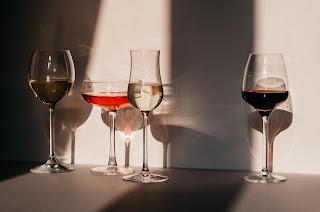Wine Classification
As
I mentioned in the previous article of “What is Wine?”, Wines are frequently
separated based on their place of origin. This is linked to the custom of using
specific grape cultivars and related grape-growing and winemaking methods in
many European nations. While wines in the New World are categorized similarly,
very few areas are consistently linked to specific styles. While much of the
New World has long used European regional names, like Chablis and Burgundy, the
more appropriate use of brand-name or grape-varietal designations is gradually
replacing this practice.
These
consist of categories including still table wines, sparkling wines, fortified
wines (dessert wines, appetizer wines). The presence or absence of the grape
skin during fermentation determines the wine's color, not the grape juice,
which is nearly always clear.
Still Table Wine
The
most elaborate classification scheme is needed for still table wines, which
comprise the majority of wines. The first classification system divided wines
into divisions according to color: white, red, and rosé. This has the advantage
of being widely accepted, but it also shows clear variations in usage, flavor,
and production techniques.
White
wines are usually produced with an acidic character because they are meant to
be consume with meals. When wine is mixed with food proteins, its acidic
quality is balanced and can complement and enhance food flavors. The majority
of white wines got little to no maturation in oak barrels. An association with
oak flavors usually benefits only those wines that have distinct varietal
aromas. Generally speaking, sweet-finishing wines are meant to be consume on
their own—either as a "sipping" wine or to go with or instead of
dessert. This category includes the majority of ice wines and botrytized
(late-harvest) wines.
The
majority of red wines made nowadays are dry. Their intended use as a food
beverage is supported by the lack of any discernible sweetness in the flavor.
Most red wines contain bitter and astringent compounds that bind to food
proteins to create a balance that would not otherwise develop. Red wines that
have aged well are occasionally kept to be enjoyed after the meal. There is no
need for food to develop smoothness because of their diminished tannin content.
Also, when there are no conflicting food flavors present, the delicate and
complex bouquet of aged wines can often be enjoyed to its finest.
Most
of red wines that age well benefit from some maturation in oak cooperage. Small
oak cooperage (225-liter barrels) storage usually speeds up maturation and adds
subtle flavors. Following in-barrel maturation, wines are typically aged
in-bottle at the winery before release. When less oak character is desired,
cooperage with a capacity of more than 1000 liters may be used. Alternatively,
the wine could be aged in inert tanks to avoid oxidation and the absorption of
accessory flavors.
One
of the most noticeable differences between red wines is the consumer market for
which they are produced. Wines processed for immediate consumption have light flavors,
whereas those processed to improve ageing potential frequently offered early
enjoyment and are initially excessively tannic. Beaujolais nouveau is a fine
representation of a wine made for immediate consumption. Premium 'Cabernet
Sauvignon' and 'Nebbiolo' wines, on the other hand, represent the other
extreme, in which long ageing is frequently required for the development of
their finest qualities.
Rosé
wines are the most maligned group of table wines. This is undoubtedly due to
their mode of production. The skins of the crushed grapes are removed from the
juice shortly after fermentation starts to achieve the desired rosé color. The
extraction of compounds that give red wines their flavor, on the other hand, is
limited. Few, if any, rosé wines age well, and as a result, they lack the
respect and following of connoisseurs. Also most have a sweet finish, which
wine enthusiasts often dismiss. To avoid the stigma associated with the term
"rosé," some ostensibly rosé wines are referred to as
"blush" wines.
Sparkling Wine
Fortified Wine
All
of the terms used to describe fortified wines are a bit misleading. Some, for
example, achieve their high alcohol content without the use of distilled
spirits (for example, sherry-like wines from Montilla, Spain). As a result,
they are not technically fortified. There are also issues with the alternative
designations of aperitif and dessert wines. Many table wines are used in the
same way that aperitif or dessert wines are. Some consider sparkling wine to be
the ultimate aperitif, and botrytized wine to be the ultimate dessert wine.
Wines
in this category, regardless of designation, are typically consumed in small
amounts and are rarely completely consumed shortly after opening. The high
alcohol content prevents microbial spoilage, and the distinctive flavor and
resistance to oxidation often allow them to be stable for weeks after opening.
These are desirable characteristics for wines that are typically consumed in
small quantities. The exceptions are Fino sherries and vintage ports, which
lose their distinct characteristics several months or hours after bottling,
respectively.
Fortified wines are made in a variety of styles. Aperitifs with a dry or bitter taste are typically consumed before meals. They stimulate the appetite and cause the digestive juices to be released. Fino sherries and dry vermouths are two examples. These are flavored with various herbs and spices. Fortified wines are typically sweet in flavor. Oloroso sherries, ports, madeiras, and marsalas are all good examples. These wines are consumed after meals or as a dessert.
Cheers to the never-ending journey of wine discovery, where each pour invites us to savour not just a beverage, but a story of craftsmanship and history in every drop. Join us for additional wine studies, where each categorization is a new chapter in this enjoyable odyssey.
*The tables of the above wine classification are unable to upload on blogger, if you need the tabular form of classification then feel free to ask.








Really informative and useful content you provide.
ReplyDelete